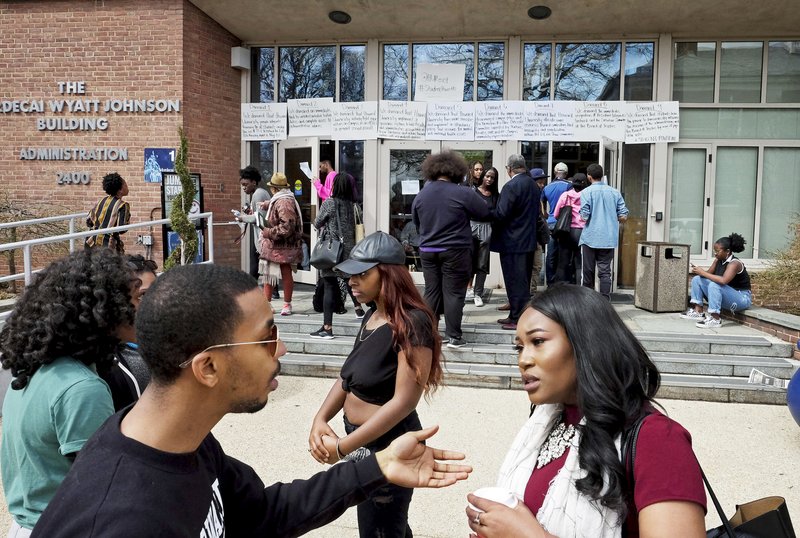傳統(tǒng)黑人院校重獲新生
A NEW ERA OF PROTEST IS ENERGIZING HISTORICALLY BLACK COLLEGES AND UNIVERSITIES
傳統(tǒng)黑人院校迎來了新的抗議時代
IT WAS A CHILLY FRIDAY AFTERNOON IN early February,
這是二月初一個寒冷的星期五下午,
and a group of young activists huddled around a table
在亞特蘭大西區(qū)一家既現(xiàn)代又接地氣的咖啡館里,
inside a modern, earthy café in Atlanta's West End neighborhood, planning their next moves.
一群年輕的積極分子正圍在一張桌子旁,計劃著下一步的行動。
Already, the group had worked to combat school privatization in the city.
在此之前,這群人就已經(jīng)在努力抗?fàn)幵撌械膶W(xué)校私有化舉措。
They had also plotted "school-to-activism pipelines" for local kids.
他們還為當(dāng)?shù)睾⒆釉O(shè)計了“從紙上談兵到行動主義的路線”。
The cause at hand now was a new stadium,
眼下的目標(biāo)是一座新建的體育場,
and how to mitigate its financial impact on the longtime residents of a black community in its shadow.
以及如何減輕這座體育場對長期居住在其陰影之下的黑人社區(qū)造成的經(jīng)濟損失。
None of it could be called schoolwork,
盡管這些問題都不算作業(yè),
yet it was exactly what Eva Dickerson aspired to three years ago when she chose to attend nearby Spelman College.
然而,這正是伊娃·迪克森三年前選擇就讀附近的斯佩爾曼學(xué)院時向往的事情。
The four year women's school is one of the country's highest-ranked historically black colleges and universities (HBCUs),
這所四年制的女校是美國歷史上排名最高的傳統(tǒng)黑人院校(HBCUs)之一——
a community of 101 schools that, as a group, have reemerged as centers of youth activism in the U.S.
這類院校一共有101所,作為一個整體,這些學(xué)校以美國青年社會運動中心的身份再次出現(xiàn)在了人們的視野之中。
As with Dickerson herself, the transition has come in stages.
與迪克森本人一樣,這一轉(zhuǎn)變也是分階段進行的。
The college junior was 16 years old when Trayvon Martin was killed in 2012.
2012年,特拉萬·馬丁被殺時,現(xiàn)在已經(jīng)大三的迪克森才16歲。
Her senior year in high school, she attended her first protests, in Baltimore, in the wake of Freddie Gray's death.
在她高中的最后一年,弗雷迪·格雷離開了人世,之后,她在巴爾的摩參加了人生的第一次抗議活動。
“I was just like, Yo, I'm black, I've got to do something,” Dickerson says.
“我當(dāng)時就覺得,嗯,我也是黑人,我得做點什么,”迪克森說。
"And then I got to Spelman, and there were black people doing things consistently and making changes."
“所以我后面就去了斯佩爾曼,那里的黑人一直在搞社會運動,推動變革。”

She wanted to be a part of the movement.
她也希望成為那場運動的一份子。
The campuses that served as incubators for the civil rights movement in the mid–20th century are experiencing something of a renaissance.
這些曾在20世紀(jì)中期發(fā)揮民權(quán)運動孵化器作用的傳統(tǒng)院校如今正經(jīng)歷著某種復(fù)興。
Freshman enrollment is up at 40% of HBCU schools,
賓夕法尼亞大學(xué)少數(shù)族裔服務(wù)機構(gòu)中心主任加斯曼透露,
says Marybeth Gasman, director of the Penn Center for Minority Serving Institutions.
這些傳統(tǒng)黑人院校的新生率已經(jīng)上漲到了40%。
Cascading national episodes of racial tension account for much of the surge,
人數(shù)激增的主要原因在于緊張的種族關(guān)系問題在全國范圍內(nèi)引起了連鎖反應(yīng),
but the new energy also draws on tension— never new—between students and administrators.
不過,學(xué)生和當(dāng)局之間的緊張關(guān)系——絕非新鮮——也為新活力的注入貢獻了一臂之力。
As in past generations, students fired by a desire for change
和前幾代人一樣,有著強烈變革愿望的學(xué)生
are less inclined to hew to the line of often institutionally minded leaders,
很少愿意服從那些有著強烈制度意識的人的領(lǐng)導(dǎo),
and protests have rocked institutions from Atlanta to Washington, D.C.,
抗議活動因此席卷了從亞特蘭大到華盛頓的各大院校,
where students at Howard University occupied the administration building for nine days this spring.
就拿華盛頓地區(qū)來說,今年春天,霍華德大學(xué)的學(xué)生就占領(lǐng)了該校的行政大樓長達9天時間。
譯文由可可原創(chuàng),僅供學(xué)習(xí)交流使用,未經(jīng)許可請勿轉(zhuǎn)載。


